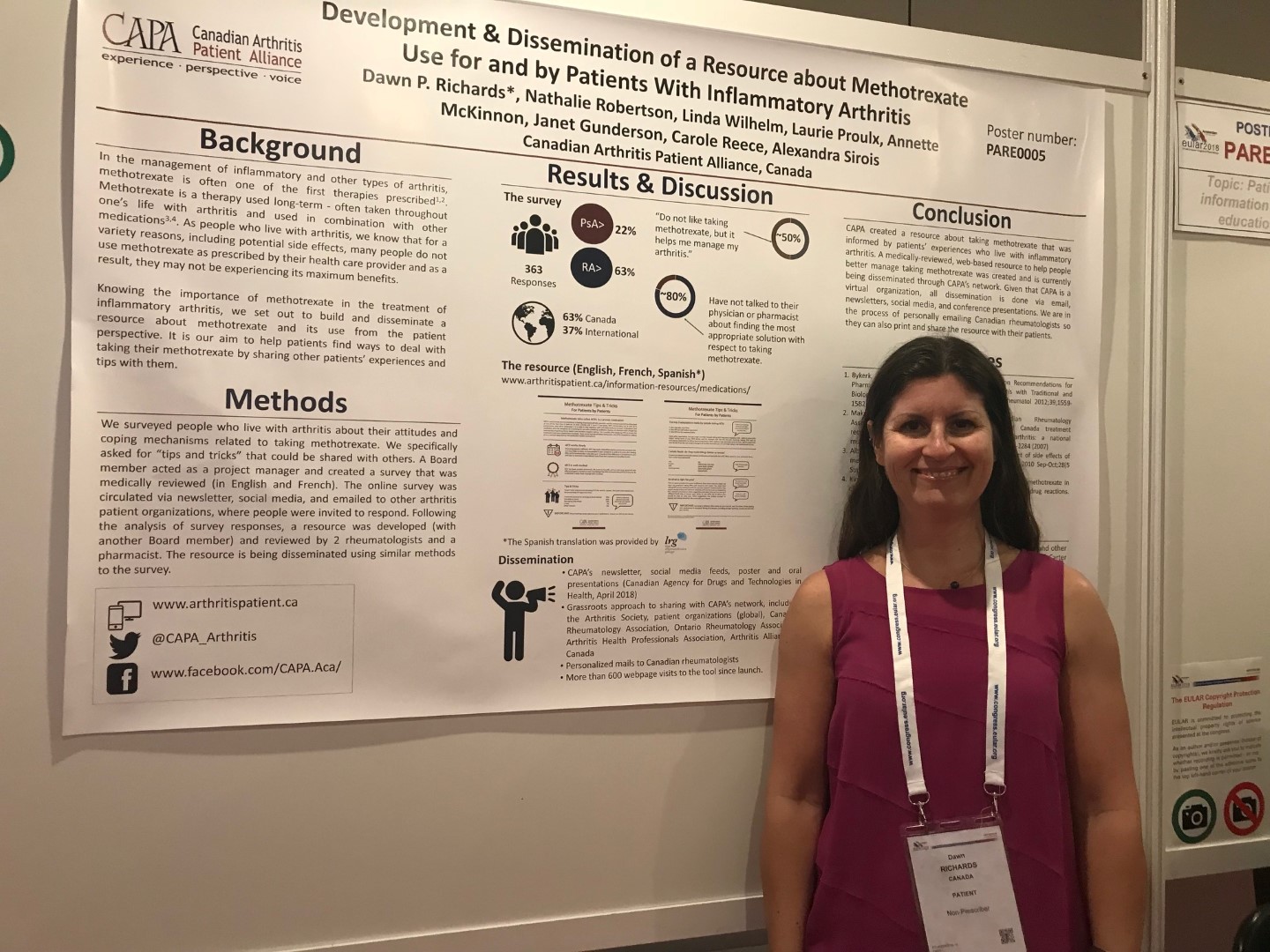CAPA Creates New Methotrexate Tool for People with Inflammatory Arthritis

Dawn Richards presenting the CAPA methotraxate tool at the Annual European Congress of Rheumatology
“We all have a story about methotrexate,” said Dawn Richards, Vice President of the Canadian Arthritis Patient Alliance (CAPA) Steering Committee.
This medication has been around for a long time and is considered the gold standard for treatment of inflammatory arthritis. That means most people encounter it at some point in their treatment. But it does have the potential to create some issues, especially side effects. “Unless you have taken it, it’s hard as a healthcare provider to understand what it really feels like.” And that’s why CAPA decided to ask people who live with inflammatory arthritis about how they cope with taking methotrexate. The responses became part of the new CAPA Methotrexate Tool, sharing tips and tricks from your peers.
“We got some really honest responses,” Dawn said. “The intent is to share that with other people, so that they can learn from their peers.” Most of the people taking the survey were from Canada, but almost 40 percent lived in other countries. About 63 percent had RA, 22 percent psoriatic arthritis, and the remainder had other types of arthritis.
The surprises
There were a few surprises. “Most people understood the importance of trying to deal with it, even though they had issues,” Dawn explained. “I think people genuinely try, but when they have some issues it’s really difficult.”
Another surprise was the finding that “about 80 percent said they didn’t even bother to ask their physician or pharmacist about solutions to taking methotrexate when they had issues. Which is pretty alarming, that this many people felt they couldn’t ask those providers for help.”
The big findings
People who take methotrexate use a number of tricks to tolerate it better. “Not surprisingly, 76 percent of people take folic acid,” Dawn said. “43 percent of people take methotrexate right before bed, 36 percent of people take it on the weekend. I think that’s reflective of people working and the weekend is a little more down time. Unfortunately, there goes your weekend, but a job is important.”
Other tips included taking the medication on a full stomach (30 percent) and switching from taking methotrexate in tablet form to using injection (30 percent). Some took anti-nausea medications at the same time as methotrexate, and then there’s the dose split. “In the past year I’ve done a dose split, where I take half of it the night before I go to bed, the other half the next morning,” Dawn told me. “For me, that really helps with the whole hangover thing.” For the uninitiated, the day-after side effects of nausea, headaches and fatigue that can occur with methotrexate is colloquially known in the inflammatory arthritis community as the hangover.
The methotrexate tool
“We took what we found in the survey and put that into useful information for people,” Dawn explained. You can find the two-page Methotrexate Tool on the CAPA website where it is available in English, French, and Spanish.
The Tool has information about methotrexate and “then we put in some of the tips and tricks that other people have told us about,” Dawn said. “And we’ve got quotes from patients, too, because I think that helps people see they are not in this boat alone.”

The CAPA Steering Committee in Amsterdam
Spreading the news
In the beginning of June, most of the CAPA Board travel to Amsterdam to present the Methotrexate Tool poster at the Annual European Congress of Rheumatology, the annual gathering of members of the European League Against Rheumatism (EULAR).
Dawn also told me that the CAPA work in this area inspired a rheumatologist to survey his own clinic and submitted an abstract to the American College of Rheumatology conference with his survey result. “We thought it was pretty cool to have a medical professional see the importance of what we were doing.”
Tag: coping, EULAR, medications, methotrexate, side effects
Read More
Discover what else I've been writing about...















